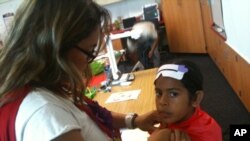Budget cuts have decimated the ability of many U.S. public schools to offer summer programs when classes are not in session, but one California school district teamed up with a nonprofit to fill that gap.
Keeping busy
The sidewalks in Santa Ana are crowded on summer days with mothers on errands, pushing young kids in strollers, usually with an older sibling or two walking alongside. Veronica Ventura’s 7- and 5-year-olds walk home while her younger daughter rides in the stroller. Ventura frets about keeping the kids at home all summer.
All they do is watch TV, she says. Crime’s going up in this area, and that worries her, too. Research indicates that kids who grow up in working class neighborhoods like this one fall behind better-off kids during the summer, says researcher John Rogers at the University of California, Los Angeles.
"So many policymakers have strongly recommended that we target summer learning opportunities to high poverty students," says Rogers. "California is going in exactly the opposite direction because as we cut back public summer school, upper middle class kids, affluent kids, have access to programs that their parents can pay for.
At Lincoln Elementary School across the street from Ventura’s house, the local school district is trying to offer some of those opportunities. Despite a $1 million cut in its summer school budget, the district was able to hire an educational nonprofit to run summer enrichment here and at 32 other sites. The programs reach one-fifth of the Santa Ana Unified School District's students.
Summer enrichment
College student Karissa Pulido, with the help of a red vinyl cape and cardboard shield, is encouraging a roomful of third graders to unlock their imaginations during the summer doldrums.
“They’re making capes and they’re making masks," she says. "And they’re going to make a name for their secret identity, or their superhero name.”
The exercise is fun and instructive, says school district official Michelle Rodriguez.
“It provides a motivational context for the other things because as they’re doing math, as they’re doing the comprehension piece, as they’re doing all of that, they are motivated due to the theme.”
Third grader Karen Quezadam, who proudly wears the hand-colored name of her superhero around her neck, is paying attention to two lists of words on the dry erase board. They’re vocabulary builders, like "dirt" next to "soil" or "student" next to the word "learner."
Teacher Karissa Pulido, who grew up nearby, says if these kids weren’t in summer school, most of them would spend hours in front of the TV or stir up trouble with other kids at home.
“Being here, they get a positive environment," says Pulido. "They get to do fun things, maybe learn about things that they’ve never seen before or heard of before.”
Looking ahead
As funding cuts worsened a few years ago, district official Rodriguez says they began to look for options which would allow them to continue summer enrichment programs.
“The district administration had the foresight to know they needed to make partnerships with other organizations so that our students didn’t suffer due to the financial deficits, so because of that, there was never a year where there was a lag.”
Rodriguez says the district hopes to expand the program next summer. She considers it a social justice issue, because working class families don’t have the same resources for camp, arts lessons and other activities that parents in more affluent areas do.








